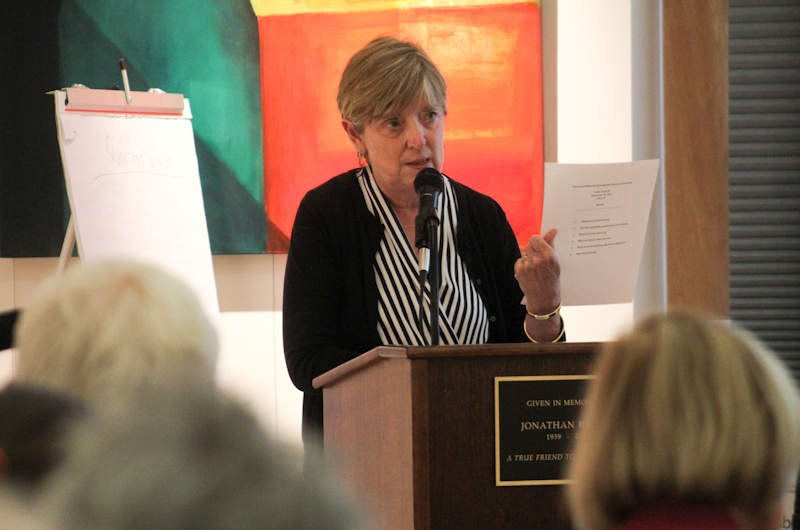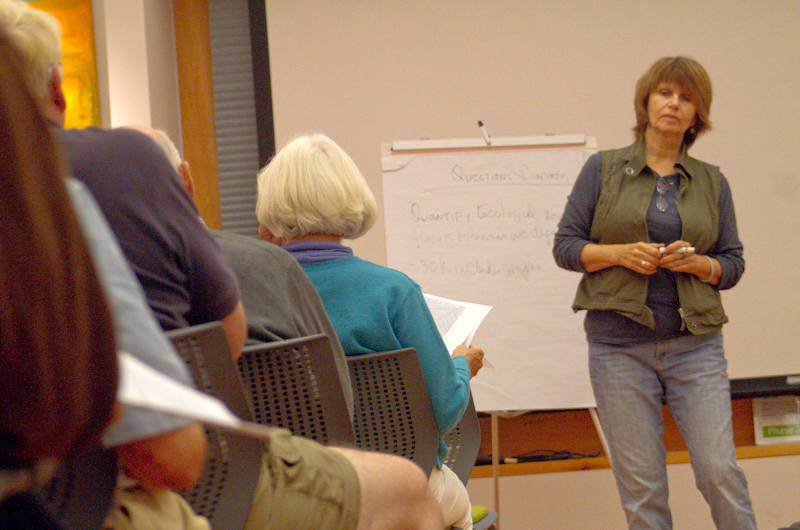A spirit of collaboration prevailed Monday evening at a forum that marks the start of a yearlong study of the Mill Brook watershed.
The watershed study begins as the fate of the Mill Pond has divided the residents of West Tisbury for several years running.
The first in a series of public forums about the issue was held Monday night, with residents bringing forward concerns and ideas for the watershed study, which will examine a 3,700-acre freshwater river system in West Tisbury.
“We are interested in what data you want to make sure we collect and also any concerns you have about this study, and questions you have,” Sue Hruby, a member of the Mill Brook watershed management committee, told the audience gathered at the West Tisbury library.
The committee has met 10 times in the past two months, mostly to determine the scope of work for the watershed study and to draft a request for proposals. The committee was appointed by the selectmen following a vote at town meeting last spring, when voters approved a watershed study but nixed a project to dredge the Mill Pond.
“I think the sentiment that was reflected by the vote was that no funding of any activity having to do with dredging Mill Pond would get support without a watershed study being completed first,” said Cynthia Mitchell, selectman and co-chairman of the committee, in introductory remarks.
“If I remember, the sentiment was, it would be the cart before the horse,” she added.
The watershed study will cost $30,000.
Mill Pond is part of a complex freshwater river system that flows into the Tisbury Great Pond. Dammed many years ago when there was a grist mill at the site, today the artificial pond is home to mute swans, Canada geese, otters and other wildlife. The pond is stocked each spring with freshwater trout and is a popular fishing spot for families and children.
In recent years the pond has been slowly filling in and has been the subject of intensifying debate, primarily over whether to dredge it.
Though Mill Pond has received the most attention, it is not the only manmade impoundment in the watershed. There’s also Priester’s Pond, Fisher Pond, Crocker Pond and Albert’s Pond, which the town seeks to better understand with the study.
People who attended Monday’s forum were invited to ask questions and to comment on the direction they’d like to see the study take.

Anna Alley said she was interested in how the legalities of water diversions in the watershed would affect the project.
“It’s complicated and really takes a legal thing to look at it, and I think if we want to do something about that, we kind of need to know what our rights are, what the town’s rights are and what landowners’ rights are,” she said.
Resident Ebba Hierta said she’d like to see the study quantify the ecological resources provided by the watershed.
“What sorts of plants and animals are dependent on this being a healthy resource?” she said.
Ms. Hruby said her primary interest was water quality.
“I’m really concerned with what we find in the water, because I’m drinking it,” she said.
The request for proposals, which goes to the selectmen Wednesday for their approval, outlines a study with a broad scope, including a review of existing data, water quality sampling at seven points throughout the watershed, measurement of water flow and an examination of water diversion, inputs and use, identifying land uses negatively impacting the water quality of the Mill Brook.
Bill Wilcox, former water resource planner for the Martha’s Vineyard Commission, suggested multiple additions to the RFP.
The committee said the document would be made available online once it is sent out to prospective bidders.
A previous version of the RFP went out to bid in 2013, but only saw one response, said selectman Richard Knabel.
Consultants who decided not to bid told the town that the scope of the study was too large for the $15,000 price tag, he said.
Despite a doubling of the funds following the annual town meeting last year, money is still a limiting factor in the scope of the study. A suggestion made Monday to take a biological inventory of the watershed was met with hesitation.
“As part of this study, knowing the complexity of it and knowing the timeline of it, the cost probably wouldn’t fit,” said Tim Boland, a committee member who is director of the Polly Hill Arboretum.
Watershed committee co-chairman Chuck Hodgkinson said the study will take place over a 12-month period, providing a “snapshot” of the watershed.
Once the project goes out to bid, the committee will oversee the study and develop a draft watershed management plan based on data collected, Mrs. Mitchell said.
If all goes according to plan, a draft watershed management plan will be presented to voters at the 2016 annual town meeting.








Comments
Comment policy »